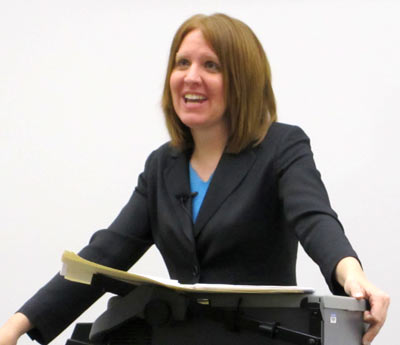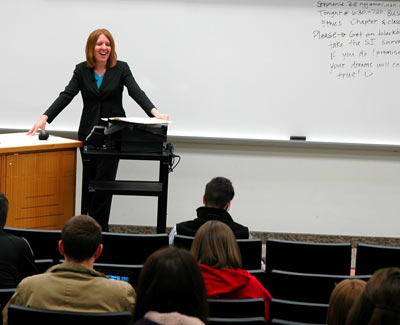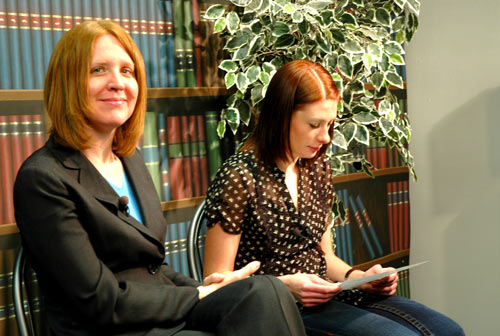Press-Supreme Court in ‘dysfunctional marriage,’ legal scholar asserts
April 16th, 2011 Posted in OpinionStory and Photos by Shirrel Cooper
LOGAN—The American public is suffering from a lack of information about their highest court, says a USU alumna who served as a clerk on the U.S. Supreme Court. This lack of understanding has created a “civics education emergency of the highest order” involving the public, the press and the Supreme Court, she said Thursday.
RonNell Andersen Jones, a 1995 journalism graduate who now teaches constitutional law at BYU’s law school, says there are volumes of empirical data confirming that the depth of public ignorance about the Supreme Court is severe. And each party—the public, the press and the Court itself—thinks it’s the other party’s fault.
 Jones has had a unique position to view this ongoing battle. Jones clerked for Associate Supreme Court Justice Sandra Day O’Connor in 2003, and compares the press-Court relationship to a dysfunctional marriage. And although everyone agrees that the relationship is unstable, both parties recognize that divorce is not an option.
Jones has had a unique position to view this ongoing battle. Jones clerked for Associate Supreme Court Justice Sandra Day O’Connor in 2003, and compares the press-Court relationship to a dysfunctional marriage. And although everyone agrees that the relationship is unstable, both parties recognize that divorce is not an option.
“The media will always need to cover the goings on of the highest court in the land in order to fully report on the richest and most socially significant of the issues of our time,” Jones said Thursday at a lecture sponsored by the Department of Journalism & Communication’s Morris Media & Society Lecture Series.
“The court will always need the media to write about their opinions in order to convey to their wider and ultimate audience both the immediate substance of their newest opinions and [to support] our constitutional democracy,” she said.
Jones said that although the press and the Court need each other, and both want an educated and informed public, neither seems capable of a harmonious relationship, resulting in incomplete public knowledge of critical legal issues that govern people’s lives in this country.
“Both parties are sure that the relationship is damaged. And each is sure that it is primarily, if not exclusively, the other party’s fault,” Jones said. “Neither is willing to acknowledge any personal accountability or responsibility for the difficulties and neither is willing to budge from their longstanding positions that contribute to the dysfunction.”
Jones said it’s this refusal to accept responsibility that is to blame for a misinformed public.
“In thinking of this as a marriage between the Supreme Court and the press, they’re both sort of shouting, ‘Look, the kids are miserable!’ and pointing at the wider citizenry that sort of watches and suffers as the tug of war between them plays out,” Jones said. “But each is saying ‘it’s all because of you.’”
 The fact that “the kids are miserable” is confirmed by data showing general confusion surrounding the highest court in the land.
The fact that “the kids are miserable” is confirmed by data showing general confusion surrounding the highest court in the land.
“In a recent poll, fewer than a quarter of Americans knew how many justices there are on the Supreme Court,” Jones said. “There are nine. Although 77 percent of American adults can identify two of the seven dwarfs, only 24 percent can name two Supreme Court justices.”
To illustrate Americans’ pitiful lack of knowledge about the third branch of the federal government, Jones turned to a clip from The Tonight Show with Jay Leno. While the audience of about 100 laughed as misinformed people answered questions about the Supreme Court in Leno’s “Jaywalking” segment, in which the late-night host asks questions of “average” people on the street. The Tonight Show clip helped cement Jones’ argument about the depth of citizen knowledge about the nation’s highest court.
“So, it seems, maybe, that the kids in our marital analogy are in fact really a mess,” Jones said. “As if somebody has in fact fallen down on the job of providing an accurate flow of helpful information about the U.S. Supreme Court to the masses.”
However, Jones, a constitutional and First Amendment law professor at the J. Reuben Clark School of Law at BYU, refuses to take sides in “The Blame Game” between the press and the Court.
“I’m a bit of an oddity,” she said. “I have no interest at all in declaring a single error in any war between the Supreme Court and the press corps that covers it. Indeed, as a scholar of both journalism and the law—and as a former newspaper reporter and editor in three different states and a former practicing attorney who worked within and practiced before the United States Supreme Court—I actually think I am in a unique position to see this conflict as having richer layers of complexity.”
Jones said that the conflict can’t be resolved by taking sides. The solution lies in having the disputing parties learn to work together, she said.
“I have this uniquely strong interest in there being an overall win here in having these two parties who never manage to see eye to eye and somehow always manage to be dragging each other through the figurative mud, learn to work together for their mutual benefit and, just as importantly, for the benefit of all of us—the kids.”
 Jones says that both journalists and the justices are to blame for the information divide. Press coverage has declined, and offers only the barest outlines of Supreme Court news, not information that might be relevant to the American people.
Jones says that both journalists and the justices are to blame for the information divide. Press coverage has declined, and offers only the barest outlines of Supreme Court news, not information that might be relevant to the American people.
“Television news is perpetually criticized for reducing important legal decisions to sound bites,” Jones said. “Their mandates for simple terms and strict time limitations put them in a place where it’s nearly impossible to capture legal details.”
Jones said that most news media just report on how Court rulings came about—who won, who lost—but miss the “why it came out that way or what it means to all of us.”
“This focus on decisions have led to what one scholar has compared to learning the score of the sporting event, but nothing about how the game was played or how the results affect the standings of the various participants,” Jones said.
Jones also said the press has the responsibility to get Court decisions to the public, but because of deadline constraints and a lack of legal training, often journalists can offer little more than an umbrella focus on Supreme Court rulings.
“The press is guilty of oversimplification and is not up to the job of understanding the hard stuff that goes on in the Supreme Court,” Jones said. “Justice Ruth Bader Ginsburg … summed up, what I think most people think—that the system of communicating the proceedings of the Court to the American people lies squarely on the shoulders of the media. Most responsible, she said, is the press for translating what Courts find into a form that the public can digest. And the general accusation is that they aren’t doing so well.”
On the other hand, Jones said, as in any troubled marriage, blame does not flow in just one direction. The Court is very sensitive about its public image, she said.
“Journalists are equally sure that it is the Court itself that is hamstringing public education,” Jones said. “The Court is blamed for being snobbish and fearful and cloistered and uncooperative. The allegation is that keeping press coverage tightly within its own control is integral in the Court’s eyes to the widespread positive public regard for the Court, at least relative to the publicly elected branches.”
Jones said that the Supreme Court does not have a public face. None of the journalists who cover Supreme Court decisions are able to meet with any of the justices. They are limited to reading the transcripts from the Court and translating them on their own.
“In the words of Linda Greenhouse,” a Yale University legal scholar and journalist-in-residence, Jones said, “the media is prevented from utilizing the most obvious journalism technique for fathoming the Court’s actions: That of interviewing the newsmakers to ask them what they meant.”
The Court’s own policies show an indifference to the press, Jones said, which hampers journalists’ ability to write detailed and well-translated reports about Court proceedings.
“Information is rarely provided, and when it is, it is provided long, long, after it would actually be useful to anyone turning around news on a modern deadline,” Jones said.
Jones said the Supreme Court drags its feet in providing same-day written transcripts, and instead releases Court opinions whenever they are completed. Because of this, many important transcripts will be released on the same day, which means a feast-or-famine relationship between the Supreme Court and the press that covers it.
When the information is finally given to the reporters, they are left to wade through the transcripts on their own, Jones said.
“This is A-okay for those of us who are scholars, with the luxury of reading them on our own time and fighting over them in our own timeframe,” Jones said. “But that kind of sheer volume is crippling to someone on a deadline. It’s no wonder that mistakes get made on occasion, or oversimplifications occur.”
 Jones said that both the press and the Court need to come together in finding a solution for this problem. She said the press can do this by becoming better trained in covering law.
Jones said that both the press and the Court need to come together in finding a solution for this problem. She said the press can do this by becoming better trained in covering law.
“At a minimum, the press needs to employ legal specialists for important cases and all reporters who write on a topic need to increase their legal literacy,” Jones said. “The public, of course, is not itself well versed in legal terminology or legal reasoning, but great writers with a legal education can convey ideas both simply and accurately to a less educated crowd.”
Jones said that the Supreme Court could also help the media by handing down Court decisions to the press one at a time, rather than all at once and by making transcripts more readily available to the news media.
“Justices of the Supreme Court often balk that their high calling ought not bend to the needs of the press—which is an absolutely backward attitude to have,” she said. “It’s not the needs of the press—it is the needs of the public they claim to serve, and they ought to be grateful that the press serves as an intermediary and do their best to accommodate it.”
While Jones never took sides in discussing the “marital divide” between the Court and the press, many students at USU saw that blame should be cast.
Freshman Steve Clark enjoyed listening to Jones, but thinks the blame for an uninformed public lies with the justices, not the press.
“I think the blame belongs more with the Court,” he said after the lecture. “They just seem too unwilling to work with the press or even with the public. They work for the people, as part of the government, yet they won’t do anything to help educate the public or make information about Court opinions more accessible or easier to understand.”
Clark said that he tries to get Court information from the media because he doesn’t have time to read the Court opinions himself.
“I’m sure there’s more I could do,” he said, “but as a student, I’m pressed for time, and some aspects of the Court are just too complicated to easily understand on a tight schedule like mine.”
Senior PR major Amber Neil also blames the Supreme Court for a misinformed public.
“I’d have to agree more that it goes with the Courts because the main point [Jones] hit on is that the Courts give such large briefings that are so technical that no one goes through them, and hopes the press and the people understand them,” Neil said.
“She mentioned that as press, we have really short deadlines. We don’t have time to sit through them, and if you’ve read one of those Court cases, they’re rough, to say the least,” Neil added. “But overall, I still think a large part of it is education of the country. People need to educate themselves, too, and research a little.”
But Amy Tran, a sophomore who is majoring in political science, disagrees that it is the Court’s fault. She pointed to the press.
“I definitely think it’s the press’s fault,” Tran said. “The Court is entitled to its privacy and to keep the proceedings professional and sacred. The proceedings are transcribed and are more available to all media, and so it’s the media’s responsibility to convey such information to the public.”
Tran likes to read the Court cases herself in order to understand the decisions.
“I try to read the cases myself, read news coverage on cases on blogs and in newspapers, and get everything else online. But I find that the best way to get information is to read the case itself,” Tran said. “There are some points that I don’t understand, but I have a friend in law school that I go to to clarify such information for me.” Tran says she plans to take law courses next year, “so that should help a lot, too.”
Jones said that the media and the Supreme Court need couple’s counseling to mend the broken relationship and to end “the blame game.”
“All told, this is a marriage that is pretty plainly in need of some lengthy and ongoing couple’s therapy,” Jones concluded. “But it is also one of the most glorious partnerships imaginable. It’s a joint effort in a mutual enterprise that is at the very core of our unique and remarkable democracy.”
Jones hopes the marriage can be saved, for the children’s sake.
“I’m hopeful that both the press and the Court can meet in the middle,” she said, “to make improvements that benefit both of their interests and that most importantly benefit the American people who so heavily rely on what both of them do.”
TP
Tags: Morris Media & Society Lecture, press-court dysfunction, RonNell Andersen Jones, U.S. Supreme Court

Sorry, comments for this entry are closed at this time.